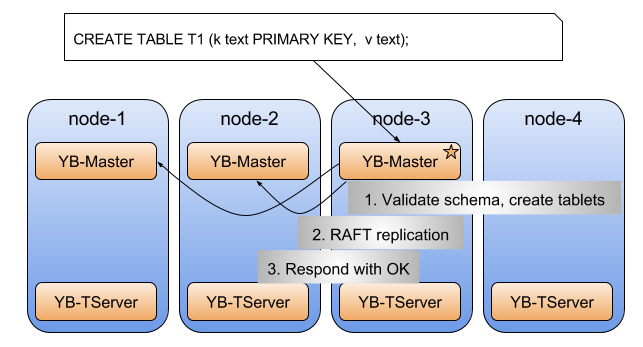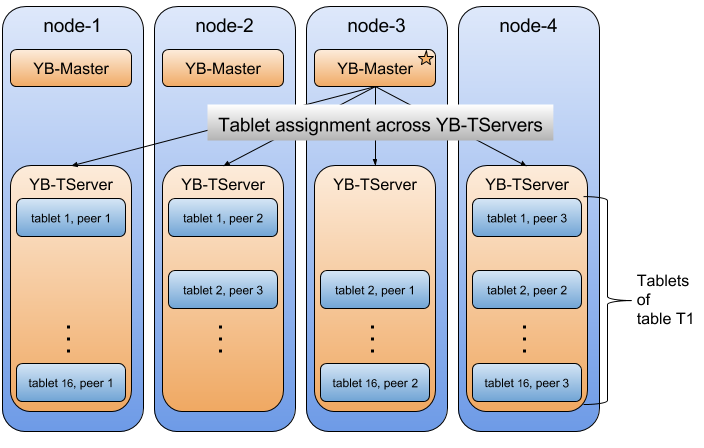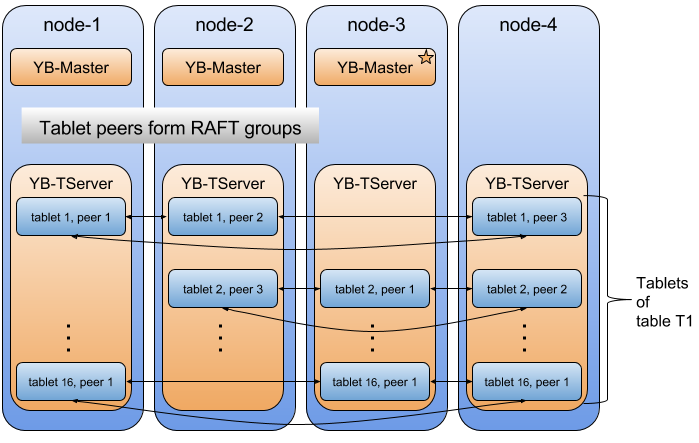Table creation
In YugabyteDB, user-issued table creation is handled by the YB-Master leader, and is an asynchronous API. The YB-Master leader returns a success for the API once it has replicated both the table schema as well as all the other information needed to perform the table creation to the other YB-Masters in the RAFT group to make it resilient to failures.
The table creation is accomplished by the YB-Master leader using the following steps:
Step 1. Validation
Validates the table schema and creates the desired number of tablets for the table. These tablets are not yet assigned to YB-TServers.
Step 2. Replication
Replicates the table schema as well as the newly created (and still unassigned) tablets to the YB-Master RAFT group. This ensures that the table creation can succeed even if the current YB-Master leader fails.
Step 3. Acknowledgement
At this point, the asynchronous table creation API returns a success, since the operation can proceed even if the current YB-Master leader fails.
Step 4. Execution
Assigns each of the tablets to as many YB-TServers as the replication factor of the table. The tablet-peer placement is done in such a manner as to ensure that the desired fault tolerance is achieved and the YB-TServers are evenly balanced with respect to the number of tablets they are assigned. Note that in certain deployment scenarios, the assignment of the tablets to YB-TServers may need to satisfy many more constraints such as distributing the individual replicas of each tablet across multiple cloud providers, regions and availability zones.
Step 5. Continuous monitoring
Keeps track of the entire tablet assignment operation and can report on its progress and completion to user issued APIs.
An example
Let us take our standard example of creating a table in a YugabyteDB universe with 4 nodes. Also, as before, let us say the table has 16 tablets and a replication factor of 3. The table creation process is illustrated below. First, the YB-Master leader validates the schema, creates the 16 tablets (48 tablet-peers because of the replication factor of 3) and replicates this data needed for table creation across a majority of YB-Masters using RAFT.

Then, the tablets that were created above are assigned to the various YB-TServers.

The tablet-peers hosted on different YB-TServers form a RAFT group and elect a leader. For all reads and writes of keys belonging to this tablet, the tablet-peer leader and the RAFT group are respectively responsible. Once assigned, the tablets are owned by the YB-TServers until the ownership is changed by the YB-Master either due to an extended failure or a future load-balancing event.
For our example, this step is illustrated below.

Note that henceforth, if one of the YB-TServers hosting the tablet leader fails, the tablet RAFT group quickly re-elects a leader (in a matter of seconds) for purposes of handling IO. Therefore, the YB-Master is not in the critical IO path. If a YB-TServer remains failed for an extended period of time, the YB-Master finds a set of suitable candidates to re-replicate its data to. It does so in a throttled and graceful manner.